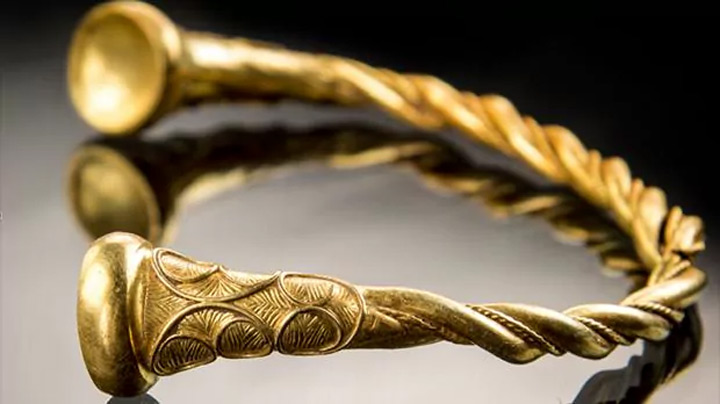A very sophisticated type of jewellery and were think through as an earliest example of Iron Age gold work in Britain were found b****d in a farmer’s field in Staffordshire Moorlands farmland.
The four twisted gold metal were composed of three neckbands and a bracelet which was named Leekfrith Iron Age Torcs.
The four torcs found in Staffordshire
It was discovered by the two metal detectorists, Mark Hambleton and Joe Kania. These torcs are assumed to be approximately 2,500 years old.
These pair excavated these jewellery, Mr. Hambleton said, “We weren’t expecting to find anything. I was just about ready to give up for the day when Joe said he thought he had found something.”
“We both looked at it and were speechless,” he added.
They continue searching around the area and found the three remaining torcs. Mr. Kania said: “We have found the odd Victorian coin, but mostly it has been junk. So I couldn’t believe it when I picked out this mud covered item and on cleaning it off, I thought this might actually be gold.”
Mr. Hambleton used to go metal detecting with his dad at an early age. He shifted into fishing but his father advised him to go back in those fields and then later decided to go back to metal detecting again. He made the right move in taking his father’s advised. His father had the chance to see these amazing pieces and prove to him that he was correct right from the start.
The pair interacted with the landowners and Mr. Hambleton was obliged to sleep with the finds by the side of his bed. He kept the gold to make certain it was safe until he could hand them to the experts. T hey took the torcs to Teresa Gilmore, a finds liaison officer for the Portable Antiquities Scheme at Birmingham.
The metal detectorists who found the torcs
Mr. Hambleton and Mr. Kania had been given the consent to search the land by the owners, Stuart Heath’s family, who farms a 640 acres land in the Moorlands. If the finds is confirmed treasure, it will be traded and divided with the family.
According to some professionals, these jewellery may have been in possession of a very well-off and influential women. Perhaps, these women moved from continental Europe in order to get hitched by rich Iron Age rulers in the local community.
The torcs were carefully b****d nested together and believed could be worth hundreds of thousands of pounds. These four torcs were found separately, roughly 1m apart b****d near the surface in Leekfrith last December.
Archeologists are certain about the facts that these have been b****d for some means of safekeeping. Another thing is that it could serve as an offering to a God, or an act of commemoration for somebody who had passed away.
A curator in the British Museum and European Iron Age collection, Julia Farley said “This unique find is of international importance.” She also added, “It dates to around 400-250 BC and is probably the earliest Iron Age gold work ever discovered in Britain.”
On Tuesday, these torcs will be exposed at a press conference. This was incredibly momentous and simply magical.
It could reveal new details about the movement of Iron Age communities.

